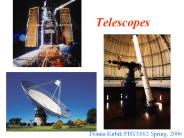Reflecting Telescopes PowerPoint PPT Presentations
All Time
Recommended
Title: Chapter 28 Subject: Earth Science Author: Glencoe/McGraw-Hill Last modified by: South Rowan Created Date: 3/26/2004 3:29:16 PM Document presentation format
| PowerPoint PPT presentation | free to download
CHAPTER 1 Optical Telescope. I. Reflective and Refractive Telescopes ... To achieve large f/ number, telescope will be long and requires massive support and domes ...
| PowerPoint PPT presentation | free to view
Adopted from 'Observational Astrophysics,' by P. Lena. Compton Gamma-Ray Observatory (CGRO) ... Astrophysics,' by P. Lena. Chandra X-Ray. Observatories. XMM ...
| PowerPoint PPT presentation | free to view
Reflecting mirror Optical Telescopes Refracting lens Optical Telescopes Reflecting and refracting ... generally can use optical telescope mirrors and lenses.
| PowerPoint PPT presentation | free to view
Reflection Regular reflection occurs when parallel light rays strike a smooth surface and reflect in the same direction. Diffuse reflection occurs when light rays ...
| PowerPoint PPT presentation | free to view
Title: Slide 1 Author: bargej Last modified by: Walter Payton College Prep Created Date: 12/14/2005 2:03:26 PM Document presentation format: On-screen Show
| PowerPoint PPT presentation | free to view
Telescopes Characteristics of Stars Lives of Stars Star Systems and Galaxies The Expanding Universe Electromagnetic Radiation The electromagnetic spectrum includes ...
| PowerPoint PPT presentation | free to download
How do they work? History Hans Lippershey Middleburg, Holland invented the refractor telescope in 1608 Galileo the first to use a telescope in astronomy.
| PowerPoint PPT presentation | free to download
Telescopes How do they work? Chapter 5
| PowerPoint PPT presentation | free to download
And that's also why the telescopes are located at very different places... The two big challenges of radio astronomy overcome by radio astronomers ...
| PowerPoint PPT presentation | free to download
One can change the magnifying power of a telescope by ... Lick. Yerkes. Observatory. 20th century Large Reflectors Come of Age. Mount Wilson. Palomar (5-m) ...
| PowerPoint PPT presentation | free to download
Long focus refractors were awkward but suffered less from chromatic aberration ... chromatic aberration. Reflecting telescope. Objective mirrors instead of ...
| PowerPoint PPT presentation | free to view
To achieve good angular resolution, radio telescopes need to have very ... SOFIA. Spitzer. Infrared. Remember that we emit infrared radiation. As does the Earth ...
| PowerPoint PPT presentation | free to view
Refracting-uses lens instead of a mirror to focus incoming light. Refraction telescopes. The objective in a refracting telescope refracts or bends light. ...
| PowerPoint PPT presentation | free to view
Give us images of things. that give off little energy, like new stars and nebula ... Hubble Space Telescope. Combination of telescopes optical and ultraviolet ...
| PowerPoint PPT presentation | free to view
a telescope is a device for collecting and bringing to a focus electromagnetic ... light' captured by curved. metal mirror' Refracting ... near-Earth asteroids ...
| PowerPoint PPT presentation | free to view
Ability to make objects appear larger in angular size ... Lick. Yerkes. Observatory. Largest refracting. telescope with a. one meter objective ...
| PowerPoint PPT presentation | free to download
The pupil admits light to the lens, which along with the cornea, focuses ... Speckle interferometry: take very short exposures -- works only with very bright ...
| PowerPoint PPT presentation | free to download
The secondary rainbow arises from two internal reflections and the rays exit the ... This effect produces a secondary rainbow that has its colors reversed ...
| PowerPoint PPT presentation | free to view
Refracting Telescopes Faint Light Astronomical objects are distant and faint. Effectively at infinity Light collection is more important than magnification.
| PowerPoint PPT presentation | free to download
The lens in your eyes works like a glass lens. ... Light rays are bent when they intersect glass; a curved surface can produce an image. ...
| PowerPoint PPT presentation | free to download
But, astronomers, cannot directly probe the objects they study because of the ... detectors, similar to those in camcorders, through a process that takes much ...
| PowerPoint PPT presentation | free to view
Neutrino Telescopes
| PowerPoint PPT presentation | free to download
Light and Telescopes
| PowerPoint PPT presentation | free to download
Reflection and Refraction TEKS 5.8B Objective 3: The student will demonstrate an understanding of the physical sciences 5.8 The student knows that energy occurs ...
| PowerPoint PPT presentation | free to view
My 10 inch (25 cm) Schmidt-Cassegrain telescope has a 250 cm focal length. If I use an eyepiece with a 1.25 cm focal length, what is the magnification?
| PowerPoint PPT presentation | free to view
Light, Reflection, and Refraction Chapters 14 and 15
| PowerPoint PPT presentation | free to view
Types of Telescopes and their advantages. Focal Length and Focal Ratio ... Most 'bang for the buck' Basic Telescope Designs. Compound. Schmidt-Cassegrain, Maksutov ...
| PowerPoint PPT presentation | free to download
Telescopes and Astronomical Instruments The 2 main points of telescopes are To make images with as much angular information as possible To gather as much light as ...
| PowerPoint PPT presentation | free to download
Radio Waves first discovered by Hertz in 1888 ... The Receiver converts the radio waves to an electric signal that is amplified and recorded. ...
| PowerPoint PPT presentation | free to view
Chapter 28 Reflection & Refraction * Physics 1 (Garcia) SJSU * * * * * * * * * * * * * * * * * * Physics 1 (Garcia) SJSU Demo: Concave Lenses Curved surface of a ...
| PowerPoint PPT presentation | free to download
... across for the Yerkes Observatory in Wisconsin, ... is to be its replacement. 3.7 You Can t Look at the Sun at Night The Solar and Heliospheric Observatory ...
| PowerPoint PPT presentation | free to view
Image Formation In Lenses. Divergent lenses. Common Optical Instruments. Camera ... bad grinding causes focus at different places--fix by combining lenses ...
| PowerPoint PPT presentation | free to view
The Radio Sky (480 MHz) Interferometers ... The X-Ray Sky. Chandra X-ray Observatory. X-rays reveal details of hot (1 ... The Infrared Sky. Blackbody Spectra ...
| PowerPoint PPT presentation | free to view
Spectrograph / Spectroscope / Spectrometer. A spectrograph uses a ... spectrograph. spectroscopy. spherical aberration. very-long-baseline interferometry (VLBI) ...
| PowerPoint PPT presentation | free to download
How close can two stars be before they blur into one? ... Telescopes at high altitude or in orbit around the Earth detect radiation that ...
| PowerPoint PPT presentation | free to view
Imaging Systems and Photometers Although CCDs for astronomy are extremely sensitive and thus expensive, ... and employ several expert optical engineers and scientists.
| PowerPoint PPT presentation | free to download
Data observed by human eyes or recorded on photographs or in computers. ... Catadioptric -Uses both lenses and mirrors. First Optical Telescopes: Refractors ...
| PowerPoint PPT presentation | free to view
Title: PowerPoint Presentation Author: Sumanas Last modified by: Hernandez, Troy Created Date: 12/24/2002 1:08:46 AM Document presentation format
| PowerPoint PPT presentation | free to download
Uses: Magnifying glass. The image formed is: Larger than the object ... Example: The image formed by a plane mirror or a magnifying glass. Real and virtual images ...
| PowerPoint PPT presentation | free to view
Everybody knows that astronomers use telescopes, but not everybody realizes that ... the ability to detect fine detail if it weren't for the shimmering (turbulence) ...
| PowerPoint PPT presentation | free to view
Title: Neutron Stars and Black Holes Author: Alexander L. Rudolph Last modified by: Alexander L. Rudolph Created Date: 1/12/2006 6:09:04 AM Document presentation format
| PowerPoint PPT presentation | free to view
Effective Area. Angular Resolution. Optical Axes. Field of View. 14FEB2005/KWC. AE2-UsersGroup ... Effective Area. Full Telescope Effective Area at 4.51 keV: ...
| PowerPoint PPT presentation | free to download
... on Mauna Kea on the Big Island of Hawaii uses 36 hexagonal mirrors to make a ... telescopes in Hawaii and Virgin Islands (8000 km) ... Map of Orion region ...
| PowerPoint PPT presentation | free to view
Title: Light: The Cosmic Messenger Author: Megan Donahue Last modified by: Babs Sepulveda Created Date: 2/2/2004 6:54:02 PM Document presentation format
| PowerPoint PPT presentation | free to download
Need medium to transmit energy, Oxygen, Nitrogen, etc or water molecules ... Twin Keck Radio Telescopes, Mauna Kea, Hawaii. Keck telescopes, Hawaii. Radio Telescopes ...
| PowerPoint PPT presentation | free to view
Light, Reflection, and Refraction Chapters 14 and 15 OPTICS Total Internal Reflection If the angle of incidence of a ray is greater than a certain critical angle the ...
| PowerPoint PPT presentation | free to view
Reflecting on MAGIC reflections
| PowerPoint PPT presentation | free to view
Feedback loop: next cycle corrects the (small) errors of the last cycle ... How do you suppose eyeglasses correct for astigmatism? ...
| PowerPoint PPT presentation | free to download
A CONCEPT FOR CHERENKOV TELESCOPES FOR ULTRA-II Florian Goebel, Anton Kabelschacht, Eckart Lorenz
| PowerPoint PPT presentation | free to download
Have you considered the extra credit observing project? ... A spectrograph separates the different wavelengths of light before they hit the detector ...
| PowerPoint PPT presentation | free to view
History, future telescopes P' Dierickx
| PowerPoint PPT presentation | free to view
Observatories and Telescopes Mauna Kea, Hawaii (14,000 ft) Why do telescopes need to be located at high altitude and dry climate ? Observing Planets and Moons Spectra ...
| PowerPoint PPT presentation | free to download
Title: Slide 1 Author: User Last modified by: User Created Date: 1/2/2005 8:13:51 PM Document presentation format: On-screen Show Company: Chariho Other titles
| PowerPoint PPT presentation | free to view
Observatories and Telescopes Mauna Kea, Hawaii (14,000 ft) Why do telescopes need to be located at high altitude and dry climate ? Observing Planets and Moons Spectra ...
| PowerPoint PPT presentation | free to download
Filters are placed in front of a camera to allow only certain colors to be imaged ... Also amateur astronomy clubs. Page 60. Why do we need telescopes in space? ...
| PowerPoint PPT presentation | free to view
























































